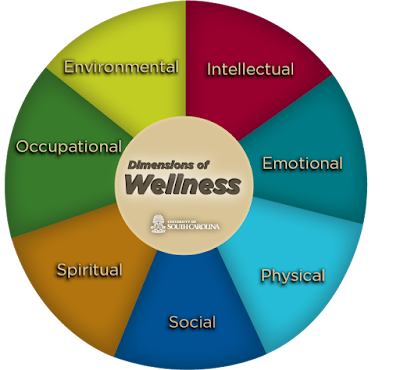A comprehensive whole-person approach to wellness
respects our complexity by acknowledging that we are multidimensional beings.
The following paragraphs explain each dimension of wellness and give practical
examples of each.
Physical. The physical dimension promotes participation
in activities for cardiovascular endurance, muscular strengthening and
flexibility. This multifaceted dimension is relative to eachperson’s abilities
and disabilities. It promotes increased knowledge for achieving healthy
lifestyle habits, and
discourages negative, excessive behavior. The physical dimension encourages participation in activities contributing to high-level wellness, including personal safety, medical self-care and the appropriate use of the medical system.
discourages negative, excessive behavior. The physical dimension encourages participation in activities contributing to high-level wellness, including personal safety, medical self-care and the appropriate use of the medical system.
Examples:
Fitness principles and movement classes;
Nutrition and weight control;
Functional abilities (ADLs and IADLs);
Lifestyle habits and safety;
Health screenings and disease prevention;
Balance, coordination, agility;
Endurance, flexibility, strength;
Breathing;
Enjoyment of movement;
Health partnerships, integrative therapies;
Alternative medical treatment, nutritional
supplements.
Emotional. The emotional dimension emphasizes an
awareness and acceptance of one’s feelings. It reflects the degree to which
individuals feel positive and enthusiastic about themselves and life. This
dimension involves the capacity to manage feelings and behaviors, accept
oneself unconditionally, assess limitations, develop autonomy and cope with
stress.
Social. The social dimension is humanistic,
emphasizing the creation and maintenance of healthy relationships. It enhances
interdependence with others and nature, and encourages the pursuit of harmony
within the family. This dimension furthers positive contributions to one’s
human and physical environment for the common welfare of one’s community.
Spiritual. The spiritual dimension involves seeking
meaning and purpose in human existence. It involves developing a strong sense
of personal values and ethics. This dimension includes the development of an
appreciation for the depth and expanse of life and natural forces that exist in
the universe.
Intellectual. The intellectual dimension promotes the
use of one’s mind to create a greater understanding and appreciation of oneself
and others. It involves one’s ability to think creatively and rationally. This
dimension encourages individuals to expand their knowledge and skill base through
a variety of resources and cultural activities.
Vocational. The vocational dimension emphasizes the
process of determining and achieving personal and occupational interests through
meaningful activities. It encourages goal setting for one’s personal enrichment.
This dimension is linked to the creation of a positive attitude about personal
and professional development.






